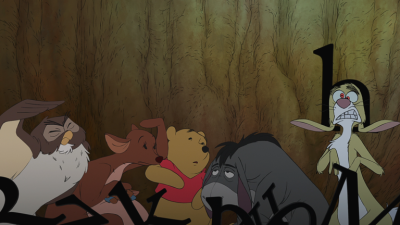 The confusingly-titled Winnie the Pooh is currently, and probably for the foreseeable future, the last traditionally-animated feature to come out of Disney. That is a somewhat more fitting (temporary?) ending than The Princess and the Frog, which, though overall okay, seemed torn between upholding the company’s traditions and injecting modern sensibilities. The new Pooh, on the other hand, is very definitely a film looking backward to the studio’s past and, for adult viewers, to the simpler time of childhood (the original trailer hits the nostalgia pretty hard). Disney even made a point of hiring Burny Mattinson, probably today’s longest-tenured Disney employee and who had worked on the original Pooh films back in the 60’s and 70’s, as head of the story department for the new instalment.
The confusingly-titled Winnie the Pooh is currently, and probably for the foreseeable future, the last traditionally-animated feature to come out of Disney. That is a somewhat more fitting (temporary?) ending than The Princess and the Frog, which, though overall okay, seemed torn between upholding the company’s traditions and injecting modern sensibilities. The new Pooh, on the other hand, is very definitely a film looking backward to the studio’s past and, for adult viewers, to the simpler time of childhood (the original trailer hits the nostalgia pretty hard). Disney even made a point of hiring Burny Mattinson, probably today’s longest-tenured Disney employee and who had worked on the original Pooh films back in the 60’s and 70’s, as head of the story department for the new instalment.
That adherence to traditions shows. The film opens, like the original The Many Adventures of Winnie the Pooh (1977), with live-action shots of Christopher Robin’s room, including all the stuffed animals to feature in the story. It is also somewhat episodic, though the subplots (getting Eeyore a new tail, “rescuing” Christopher Robin from a scary creature, and Pooh’s pursuit of honey) are more interwoven than the three originally-separate short films. There are even similar story beats (like a stylized song sequence illustrating the characters’ understanding of a fictional nightmare beast and Tigger… “expressing” himself).

That said, it can feel like certain characteristics of the originals are dialed up in a way that gets in the way of telling the story. For instance, the literary device of characters talking to the narrator and playing with the letters of the book they’re in is used more extensively than I remember from Many Adventures. The characters seem a little dumber, flanderised, an impression that may come from the excessive use of puns and misunderstandings for humour. The animation, particularly for Rabbit and Owl, occasionally feels too “hyper”, too busy, as does the musical underscore by Henry Jackman.
On the whole, though, the animation is charming and expressive, an upgrade from the (mostly) direct-to-video Pooh movies, as should be expected for a “canonical” Disney film. There is some noticeable help from computers in some scenes, foliage and effects, mainly; the honey sequence is allegedly completely hand-drawn, but doesn’t exactly look that way. A scene drawn in the style of a child’s chalk drawings is a particular highlight, and the animation on top of the watercolour backgrounds is likely to be the main draw for adults (nostalgia notwithstanding).

The songs, while innocuous, are not particularly memorable; the songwriters, by Robert and Kristen Anderson-Lopez, did a better job on Frozen (2013) two years later (I was surprised, however, how well Zooey Deschanel’s voice, which is used prominently in several songs, fit in). Add to that that the whole movie is somewhat slight both in subject matter and in running time (barely 50 minutes without credits), and one can’t shake the feeling that the film was made more as a cash-grab and less because its makers actually had something new or interesting to say about or with A.A. Milne’s characters. It’s still pleasant enough, but ultimately inferior to the original, and as such another sequel that didn’t really need to be made.
